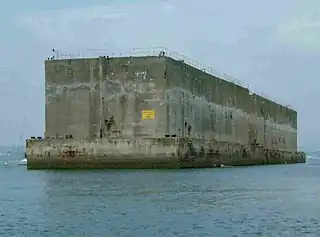

The Portland Mulberry Harbour Phoenix Units are two reinforced concrete caissons, built as part of the artificial Mulberry harbours that were assembled as part of the follow-up to the Normandy landings during World War II. Out of a total of 213 (212 floated) produced units, two units still remain at the Isle of Portland, in Dorset, southern England. They are located at Portland Harbour, close to Queen's Pier.[1] The two units became Grade II Listed in 1993.[2]
History
When planning the invasion of France the allies knew they needed to supply the troops who were ashore. The only reliable method of landing resources was through a major port. As the German army held all of France's harbours, the solution was the Mulberry harbours. A building program followed, creating two operational harbours within two weeks.[3] The Mulberry harbours were considered a success in their supporting role of Allied troops.[4]
Following the war, ten units were towed to Portland Harbour.[5] Eight of these were later sent to the Netherlands to block breaches in the dykes after the great storm of 31 January 1953.[3] The two units left behind are now used as a wind break, helping ships berth at Queen's Pier.[3] In 2017, six statues were installed on the tops of the units, representing two British Sailors, two American GIs and two Dock workers.[6]
References
- ↑ "Other Projects". Retrieved 28 September 2014.
- ↑ Historic England. "Details from listed building database (1203075)". National Heritage List for England. Retrieved 28 September 2015.
- 1 2 3 "Mulberry Harbour survey". Retrieved 28 September 2014.
- ↑ Schulz, Eugene G. (1 December 1945). The Ghost in General Patton's Third Army: The Memoirs of Eugene G. Schulz ... - Eugene G. Schulz - Google Books. Xlibris Corporation. ISBN 9781477141441. Retrieved 4 November 2017.
- ↑ "Other Projects". Retrieved 28 September 2014.
- ↑ "Planning Application Details". Webapps.westdorset-weymouth.gov.uk. Retrieved 4 November 2017.